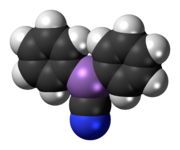
| |

| |
| Names | |
|---|---|
| Preferred IUPAC name
Diphenylarsinous cyanide | |
| Systematic IUPAC name
Diphenylarsanecarbonitrile | |
| Other names
Clark 2
Diphenylarsinecarbonitrile | |
| Identifiers | |
3D model (JSmol)
|
|
| ChemSpider | |
| ECHA InfoCard | 100.041.545 |
| EC Number |
|
| MeSH | Clark+2 |
PubChem CID
|
|
CompTox Dashboard (EPA)
|
|
| |
| |
| Properties | |
| C13H10AsN | |
| Molar mass | 255.002920742 g mol−1 |
Except where otherwise noted, data are given for materials in their standard state (at 25 °C [77 °F], 100 kPa).
| |
Diphenylcyanoarsine, also called Clark 2 (Chlor-Arsen-Kampfstoff 2, being the successor of Clark 1) by the Germans, was discovered in 1918 by Sturniolo and Bellinzoni[1] and shortly thereafter used like the related Clark 1 gas by the Germans for chemical warfare in the First World War. The substance forms colourless, garlic-smelling crystals and causes nausea, vomiting and headaches. It can subsequently lead to e.g. pulmonary oedema (fluid on the lungs).
See also
References
- ^ Sturniolo, G. und Bellinzoni , G. (1919); Boll. chim. pharm., 58, 409–410